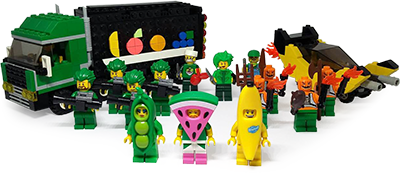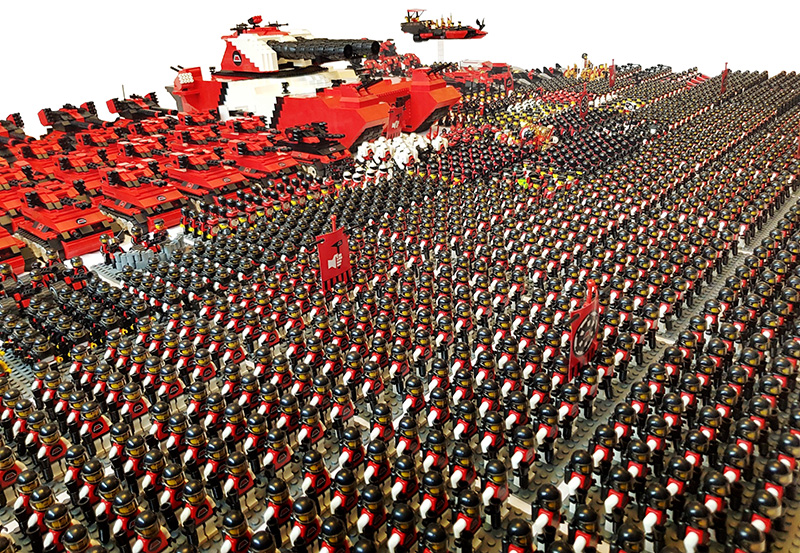|
Chapter 11
Heroic Escapades
In war, legions of minifigs fight and die by the ones and twos and trillions, bravely making the ultimate sacrifice so that their anonymous deaths can provide a cool backdrop for the Heroes whose adventures actually matter. As anyone who's seen a movie or read a comic book knows, nothing meaningful is ever accomplished by the masses of regular troopers following masses of regular orders. Their job is to convert themselves into masses of regular casualties fast enough to inspire a Hero to rise up and move the story forward. The courses of minifig wars are determined by the natural protagonism of these Heroes and the success or failure of their Heroic Escapades. In a campaign of Heroic Escapades, each player takes control of a faction's Heroes and their accompanying Army in their fight to upstage rival Heroes and seize valuable Loot (Chapter 12: Fabulous Loot). Each Hero pursues ever-greater heights of Irresponsibility until he either defeats and humiliates all opposing Heroes or until his campaign Budget runs out. (If his efforts happen to advance his home faction's strategic goals in the process, all the better.) A campaign of escalating mayhem doesn't happen by itself. It relies on the greed and vanity of Heroes, driving them to seize the initiative and drag their Armies into one bloody conflict after another. Each Heroic Escapade is a single battle instigated by a Hero deciding to grab some Loot. The order in which the Heroes get to take the role of Escapading Hero is up to the players. If it's not dictated by the campaign plot, the players might give the initiative to whichever Hero has the smallest surviving Army, or to the Hero whose faction has been waiting the longest, or to the Hero whose player's Escapade idea sounds the most fun. Apart from local Garrison defenders and unsuspecting bystanders, any force participating in an Escapade must be led by one or more Heroes. Players can use the Escapade as an opportunity to spotlight their existing Heroes, introduce new ones, or re-introduce defeated ones.  Fruit Corp is the number one produce company in the BrikVerse, according to nine out of ten Fruit Corp marketing executives. The board of directors is helmed by ruthless billionaires Priscilla Peapod, Wally Watermelon, and Bruce Banayne.
 Fruit Corp and its paramilitary force are often assisted by the mysterious crimefighter Fruitbatman. No one can figure out his true identity. It's a total mystery.
image rights: Arkbrik, signed 7/23 Uploaded, final
When Loot and glory beckon, Heroes rise, stealing the spotlight from lesser minifigs who foolishly built their careers on hard work and sacrifice rather than dramatic poses and fantastic wardrobes. At the beginning of each Escapade, players can spend from their Budgets to attract new Heroes for two Unit Inches each (11.2: The Budget). A player with a defeated Hero can spend one Unit Inch for him to make a miraculous recovery. If a Hero makes his miraculous recovery while held prisoner by an enemy faction, he remains imprisoned, but can now take an active role in his own rescue attempts. An Escapade only lasts as long as its Heroes do. Without a Hero's charisma and inspirational posturing, normal minifigs and their immediate superiors back home will suddenly remember all the work they were supposed to be doing before they got suckered into another damn fool crusade. If all of a player's Heroes in an Escapade are eliminated or removed from the battlefield, their remaining forces must immediately choose a Fighting a Losing Battle scenario (MC.5: Endgames). While regular minifigs stand eternally ready to ignore orders and circumvent the chain of command, it takes an inspiring Hero to harness that collective insubordination and construct adventures out of it. A Hero's combat abilities and willingness to ignore reality are impressive in their own right, but his greatest asset is his Irresponsibility. The more Irresponsible a Hero becomes, the larger and more ridiculous Escapades he can stage for larger and more ridiculous Loot. Whenever new Heroes or campaigns are introduced, each Hero starts with an Irresponsibility level of 1, regardless of their adventures in previous campaigns. After each Escapade, the Irresponsibility of every participating Hero increases by one level, as long as their forces managed to kill or destroy at least one enemy unit. This increase applies even and especially if the Hero lost, died, or ran away like a coward. The maximum Size inches of any unit a Hero brings into battle, and the Unit Inch value of any Loot he targets with an Escapade, are equal to his Irresponsibility level. The ultimate scope and scale of a campaign of Escapades are determined by how closely the Humans' ambitions line up with their schedules, brick supplies, and attention spans. But as far as the Heroes know, the size and length of a campaign is determined by the amount of Budget they can trick their faction into throwing at it. Assuming their plans aren't abandoned halfway into the first battle by the Humans' great new ideas for a hundred unrelated storylines, campaigns always expand to match whatever Budgets are available for their consumption. A Hero's Budget is counted in Unit Inches. These Unit Inches represent the cash, manpower, and production resources his faction has made available for him to recruit, repair, and replace units over the course of his campaign. Heroes can slow their Budget's decline by reusing units and raiding for treasure, but all Budgets inevitably run out. A Hero who wins in every battle is still defeated if his units are wiped out when he has no Budget left to replace them. Campaign victory is a matter of making sure all the other Heroes run out of their units and Budgets first.
Non-Heroic units in a BrikWars campaign use the standard Unit Inch values introduced in MOC Combat (MC.1 Making MOCkeries). Active combat units are worth as many Unit Inches as their Size inches. Inactive structures and non-combat units have no Unit Inch value. While the MOC Combat system covers basic units, a number of new variations are introduced in Heroic Escapades. The list of available minifig Specialists is greatly expanded (Chapter S: Minifig Specialists). Most are worth one Unit Inch, with a few exceptions: bargain-bin Specialists like the Worker and the Cannon Fodder are worth one half Unit Inch each, and unique Specialists like the Hero and the new Great Leader are each worth two Unit Inches. Units and items can also be enhanced by Heroic Feats and SuperNatural Dice (D.2: SuperNatural Dice). Apart from Heroes and any other special exceptions negotiated by the players, these are unique items that can't be purchased as part of normal Army development. They can only be gained as Loot in Escapades.

Controlling thousands of worlds across the Tharcan Galaxy, the M-Throne Empire is committed to establish the Greater Good for all life-forms by all means necessary. No one has been able to define the Empire's "Greater Good" precisely, but their "all means necessary" is the largest assembled military force in intergalactic space. Photo: Azmi Timur From "M-Throne Imperial Army Overwatch" Elements shown: LEGO, custom banners and stickers image rights: Azmi Timur, signed 7/23 Uploaded, final
A Hero's Army is the collection of minifigs, vehicles, and other units assembled to die ridiculous deaths in his Escapades, constructed in physical form by the Hero's player. When attacking, defending, or randomly showing up to sow chaos, the Hero selects some or all of the units from his Army to take to battle. Regardless of the size or power of the Hero's home faction, the units that he's able to recruit to any specific campaign tend to always be roughly equivalent to the threats he's opposing. Dramatic law dictates that his faction's other military assets are deployed elsewhere and committed to unrelated agendas. 
The Great Peace of Skion was broken when the Swarm attacked. Having mastered magic and science but forgotten the arts of war, the Skion had no choice but to reeducate themselves in a hurry. image rights: Dienekes22, signed 7/28 Uploaded, final
The condition and composition of a Hero's Army will change over the course of a campaign as it takes damage and casualties, and as it recruits, builds, or captures new units and equipment. 
The Grek Archohellene forces are led by gods and goddesses: Enyo, who is Discord; Ares Warmaker, the great Hero; and Apollo Far-Striker, the Grek Commander. image rights: Dienekes22, signed 7/28 Uploaded, final
At the beginning of a campaign, a Hero can spend some or all of his faction's Budget building a starting Army with whatever units he feels are appropriate. The army might be made up of veterans and survivors of his previous campaigns and adventures, or they might be fresh recruits with no idea what they're getting themselves into. It can be a good idea for a Hero to hold some Budget in reserve when he recruits his initial Army units. This will allow him to make repairs and bring in reserves specifically tailored to counter his opponents' unit assortments and the changing tactical situation. An Army can include units that its Hero isn't Irresponsible enough yet to deploy in the field. It's only a matter of time before his Irresponsibility level catches up. Once a campaign is underway, a Hero can recruit new units between Escapades, as long as he has the Budget to do so. If the Budget runs out, his only hope is to try to capture more units or more Budget resources as Loot. 
The Assyrian warship Sonks, captained by the legendary Major Natalya, is the most decorated ship in the Assyrian Space Force. 
After first seeing action as a Longinus IV-B class Corvette, the Sonks has been retrofitted into a Venus class Destroyer in response to the escalating threat from the Stranian capital ship Hodgepodge and its supporting fleet. Due to the volatility of the division-by-zero point energy system powering the ship's unstoppable Hyper Phase cannon, a project of this magnitude can only be undertaken on the Assyrians' high-security Beige Carpet Shipyards, drawing on the stability of the plane underlying all existence. image rights: Natalya, 4/20/20
A Hero doesn't get any refunds for scuttling, selling, or self-destructing old or unfashionable units. Instead, the Army can prolong its units' service by spending Budget to upgrade obsolete units and repair damaged ones. As a cost-saving measure, units already in the Army can be combined or used as spare parts. It's common to pull minifigs off of infantry duty to replace missing operators, reassign Horses to pull abandoned chariots, or pull the cannon turret off a non-functional tank chassis to reattach it to a still-functional golf cart. The Budget cost of a retrofit or repair is the difference between the value of the unit or units the Army started with and that of the unit it finishes with. (The minimum cost is zero Unit Inches; an Army can't get Budget back by downsizing units.)
| |||||||||||||||||||||||||||||||||||||||||||||||||||||||||||||||||||||||||||||||||||||||||||||||||||||||||||||||||||||||||||||||||||||||||||||||||